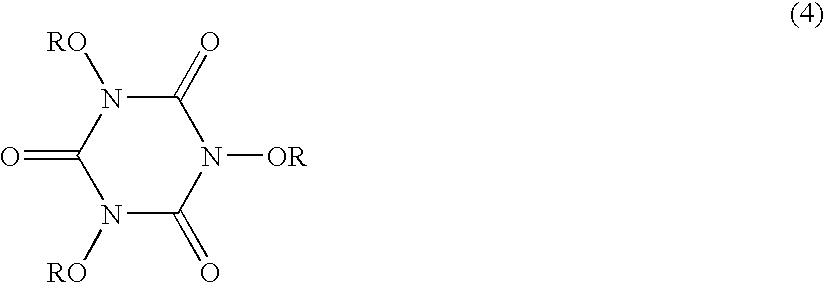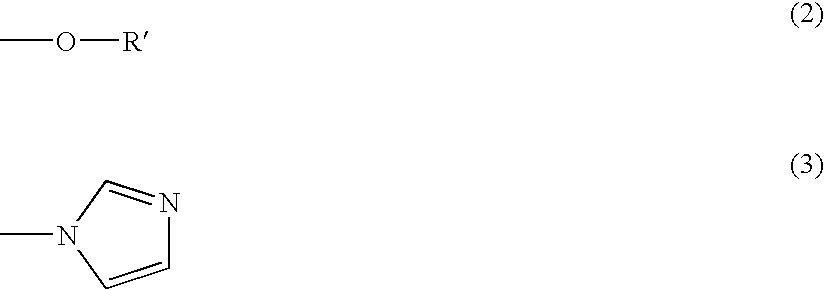Process for production n,n',n"- trisubstituted isocyanuric acids
a trisubstituted isocyanuric acid and process technology, applied in the field of trisubstituted isocyanuric acid production processes, can solve the problems of poor operability in reaction or aftertreatment, unsatisfactory methods, etc., and achieve the effects of high yield, convenient and convenient production, and high yield
- Summary
- Abstract
- Description
- Claims
- Application Information
AI Technical Summary
Benefits of technology
Problems solved by technology
Method used
Image
Examples
production example 1
Production of phenyl N-benzyloxycarbamate
[0064] In a flask were placed 3.19 g (20 mmol) of O-benzylhydroxylamine hydrochloride, 3.16 g (40 mmol) of pyridine and 40 ml of acetonitrile, followed by stirring at 0° C. in an atmosphere of nitrogen. A total of 3.13 g (20 mmol) of phenyl chloroformate was added dropwise from a dropping funnel while holding the temperature of reaction mixture to 0° C. to 2° C., followed by stirring at 25° C. for 2 hours. The resulting reaction mixture was concentrated, mixed with 50 ml of ethyl acetate, and the precipitate was removed by filtration. After washing the precipitate with 30 ml of ethyl acetate, the filtrate was sequentially washed with 40 ml of a 0.5 N aqueous solution of hydrochloric acid, 20 ml of water and 20 ml of a saturated aqueous solution of sodium chloride. The organic layer was dried over magnesium sulfate and concentrated, followed by removal of the solvent using a vacuum pump. The residue was mixed with 20 ml of hexane, pulverized,...
example 1
[0067] A total of 1.60 g (10 mmol) of O-benzylhydroxylamine hydrochloride was mixed with 1.58 g (20 mmol) of pyridine and 20 ml of acetonitrile, followed by stirring at 0° C. in an atmosphere of nitrogen. After adding dropwise 1.57 g (10 mmol) of phenyl chloroformate while holding the temperature of reaction mixture to 0° C. to 2° C., the mixture was stirred at 25° C. for 2 hours. The reaction mixture was concentrated, mixed with ethyl acetate, the precipitate was filtrated, and the filtrate containing phenyl N-benzyloxycarbamate was concentrated. A total of 1.22 g (10 mmol) of 4-dimethylaminopyridine (DMAP) was added to the concentrated residue, followed by heating on a bath at 120° C. for 20 minutes. After cooling, 10 ml of methanol was added, followed by stirring for 30 minutes. The precipitate was filtrated, washed with 10 ml of methanol, and dried under suction for 1 hour. The subsequent heating and drying at 80° C. under reduced pressure for 12 hours yielded 1.22 g (yield: 82%...
example 2
[0071] In a 500-ml four-neck flask equipped with a condenser tube, thermometer and dropping funnel were placed 16.0 g (100 mmol) of O-benzylhydroxylamine hydrochloride, 15.8 g (20 mmol) of pyridine and 200 ml of acetonitrile, followed by stirring at 0° C. in an atmosphere of nitrogen. After adding dropwise 15.7 g (100 mmol) of phenyl chloroformate from the dropping funnel while holding the temperature of reaction mixture to 0° C. to 2° C., the ice bath was removed, followed by stirring for 2 hours. The reaction mixture was concentrated, mixed with 500 ml of ethyl acetate, and the precipitate was filtrated. After washing the precipitate with 300 ml of ethyl acetate, the filtrate containing phenyl N-benzyloxycarbamate was concentrated. The concentrated residue was mixed with 12.2 g (100 mmol) of 4-dimethylaminopyridine (DMAP), followed by stirring on a bath at 90° C. At the time when the reaction temperature attained the highest (96° C.), the temperature of the bath was raised to 120°...
PUM
| Property | Measurement | Unit |
|---|---|---|
| temperature | aaaaa | aaaaa |
| temperature | aaaaa | aaaaa |
| temperature | aaaaa | aaaaa |
Abstract
Description
Claims
Application Information
 Login to View More
Login to View More - R&D
- Intellectual Property
- Life Sciences
- Materials
- Tech Scout
- Unparalleled Data Quality
- Higher Quality Content
- 60% Fewer Hallucinations
Browse by: Latest US Patents, China's latest patents, Technical Efficacy Thesaurus, Application Domain, Technology Topic, Popular Technical Reports.
© 2025 PatSnap. All rights reserved.Legal|Privacy policy|Modern Slavery Act Transparency Statement|Sitemap|About US| Contact US: help@patsnap.com



